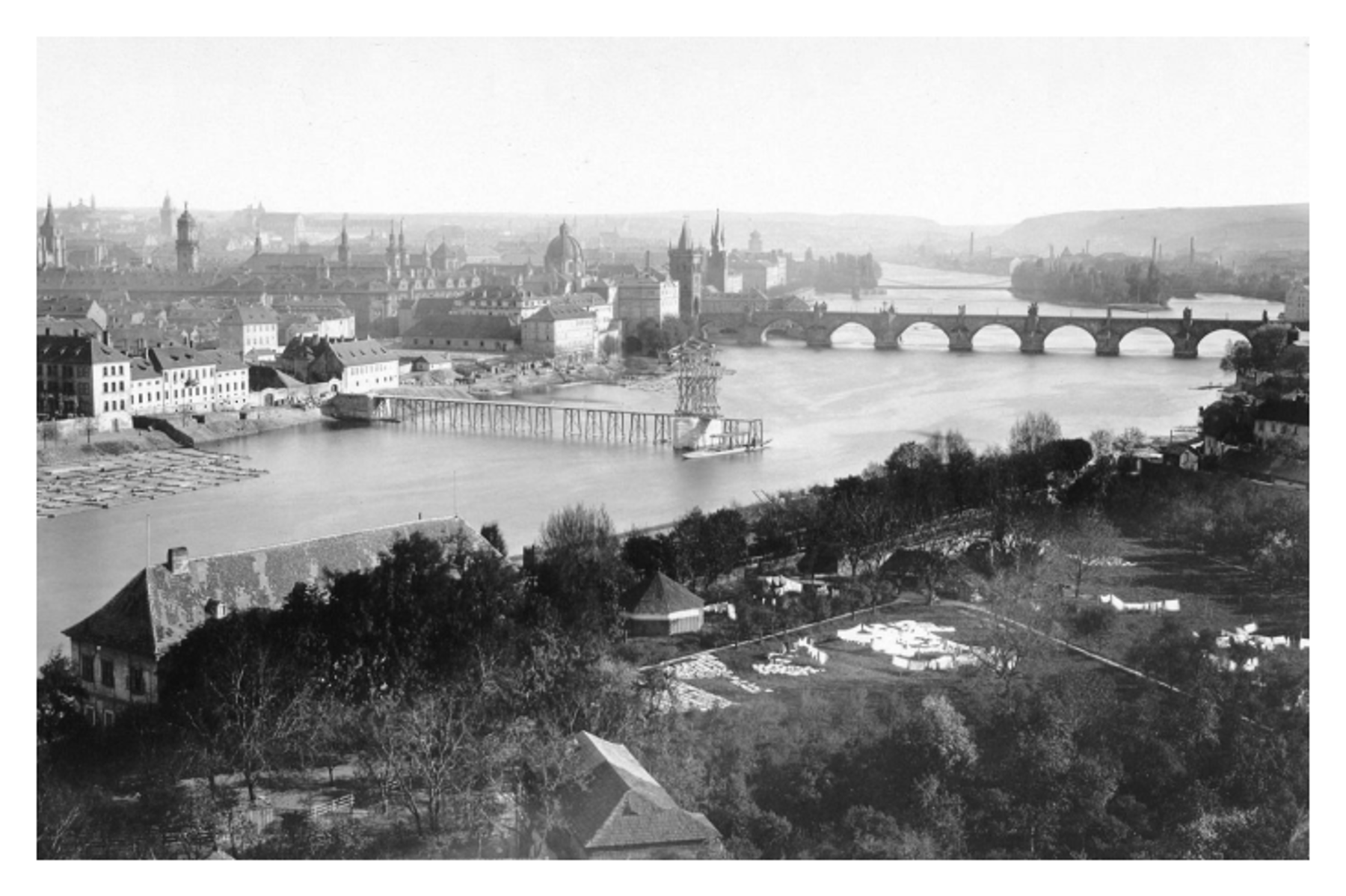The idea to build a footbridge from the Old Town to Klárov was conceived in 1866 in relation to the construction of the Franz Josef Bridge. Although bridging the Vltava river at the site of today’s Jan Palach Square had already been considered in the late 1830s, in the end, the inhabitants of Prague had to make do with a ferry for nearly three decades.
Before the construction of the footbridge, the place on the Old Town bank known as Rejdiště was an inner periphery of the city used for economic purposes. Alongside the houses, there were various fences for storing wood and other materials, the sawmill of the knight Lanna stood nearby, and the municipal knacker also had their mansion and hutches here. The new bridge project thus essentially represented the first stage of the transformation of the whole area, which was followed a few years later by the construction of Rudolfinum (from June 1876), the School of Arts (1882), the Museum of Decorative Arts (1897), and also the improvement of the embankment (1878).
Footbridge in Numbers
Names: chain, iron, Rudolf, Crown Prince Rudolf Footbridge
Construction: 1868–1869
Length: 192.02 m
Width: 3.35 m
Cost: 294,000 guldens
In use: 1869–1914
The Construction Works
The construction began on 1 July 1868 and was completed in less than seventeen months.Between 23 and 25 November 1869, a static load testing was carried out with the use of straightened bricks and, on 28 November, the footbridge was “handed over for public use” [1].
The bridge plans were drawn up by the knight Karel Veselý under the guidance of London engineers Rowland Mason Ordish and William Henry Le Feuvre and supervised the successful progress of the work himself. The construction was carried out by František Schön’s company. The ironwork, apart from the carrying chains and bearings, was supplied by the Ruston and spol. company of Prague.
As was common at the time, the construction funds were raised by setting up a joint stock cooperative and selling 1,300 shares with a nominal value of 200 guldens. The return on the investment guaranteed the cooperative and its shareholders a right grant to collect tolls for sixty years.
The Steele Beauty
The footbridge consisted of a suspended chain structure which was supported by one masonry pillar in the middle of the Vltava river and two coastal anchor pillars. A cast-iron bridge gate with two pylons 17.5 meters high was erected on the central pillar. The massive chains on which the weight of the footbridge rested were made by Sheffield ironworks.
Underneath the cast-iron and timber trusses, gas pipes ran; one for the Lesser Town and the other to supply the footbridge lighting. The seven gas lanterns were mounted on semi-circular chain link braces and their light gave a magical appearance to the footbridge and the river flowing below.
View of the footbridge from Rudolfinum. In the foreground, we can see the construction material.
The Bridge Gate
Until 1878, a winding platform led from the Old Town bank to the footbridge and disappeared when the embankment wall was built. The modifications shifted the entire bank more into the Vltava riverbed and, from then on, pedestrians entered the footbridge through a brick gate directly from the Crown Prince Rudolf Embankment, today’s Alšovo nábřeží.
The Toll
The footbridge was slightly swaying, but was not a source of defects as other bridges in Prague. The crossing was subject to bridge tolls as on all Prague bridges except from the Charles Bridge which was exempted from payment in 1815 by an imperial decree. The toll was “one kreutzer for a pedestrian, two kreutzers for carts of one wheel (wheelbarrows) or of two wheels” and “three kreutzers for carts of four wheels”.
The Change of Guards
The footbridge was designed for pedestrians only, which became increasingly inadequate as the transport needs grew. Therefore, the Prague municipality began considering a new bridge that would also serve trams, carriages, and first cars well.
The Archduke Franz Ferdinand d’Este Bridge construction, today’s Mánes Bridge, did not take place until the period between 1911 and 1914. After its completion, the Rudolf Bridge was dismantled. The photograph shows the coexistence of the two bridges for several months in 1914. In September of that year, however, all that remained of the iron footbridge was a lone pillar protruding from the Vltava river, “decorated with a scarf and colored streamers at the top”.
Memories of the Bridge
What reminds of of the chain bridge are the name of the U Železné lávky (“Chain Bridge”) Street near the Straka Academy and the preserved half-timbered house on the Kosárek embankment in the Lesser Town which was used for collecting bridge tolls. Since 1977, Gemini, an association for children, youth, and adults, has been residing there.








what are the considerations when purchasing used metal cabinets? visit our : telkom university